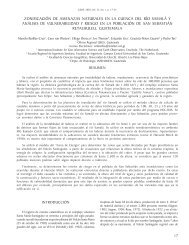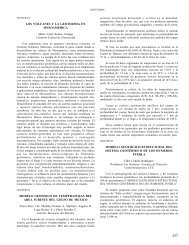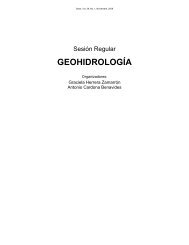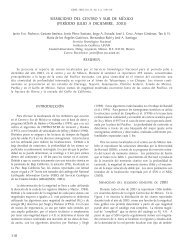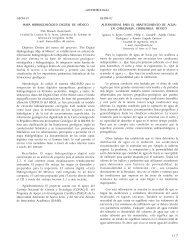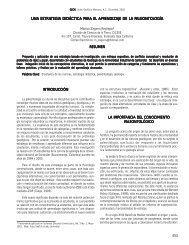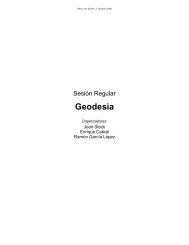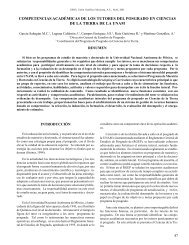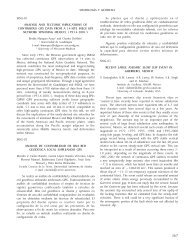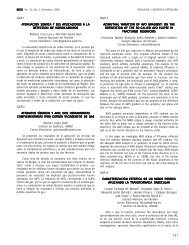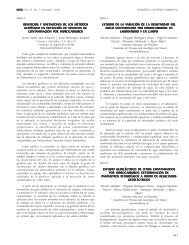GEOLOGÍA ESTRUCTURAL Y TECTÓNICA Geos, Vol. 31, No. 1, Noviembre, 2011GET-1GEOMORFOMETRÍA DEL ESCARPE PRINCIPAL DEL GOLFO:ANÁLISIS COMPARATIVO ENTRE SIERRA SAN PEDROMÁRTIR Y SIERRA JUÁREZ, BAJA CALIFORNIA, MÉXICODíaz Torres José <strong>de</strong> Jesús 1 , Fletcher John 2 ,Martín Barajas Arturo 2 y Suárez Vidal Francisco 21 Tecnología Ambiental, CIATEJ2 División <strong>de</strong> Ciencias <strong>de</strong> la Tierra, CICESEjdiaz@ciatej.net.mxEl Escarpe Principal <strong>de</strong>l Golfo es un rasgo tectónico y geomorfológico que <strong>de</strong>fineel límite oeste <strong>de</strong> la Provincia Extensional <strong>de</strong>l Golfo y el este <strong>de</strong> la microplacaBaja California. En el norte <strong>de</strong> Baja California, el Escarpe Principal <strong>de</strong>l GolfoAlcanza 2.5 km <strong>de</strong> relieve <strong>de</strong>finido por los segmentos <strong>de</strong>l frente montañosooriental <strong>de</strong> Sierra San Pedro Mártir y Sierra Juárez. Aunque su aparienciageneral es similar, estos dos segmentos están controlados por fallas activas condiferente geometría y cinemática. El escarpe <strong>de</strong> San Pedro Mártir se formó en elbloque <strong>de</strong> piso <strong>de</strong> un sistema <strong>de</strong> falla normal con <strong>de</strong>slizamiento al este, mientrasque el escarpe <strong>de</strong> Sierra Juárez se formó en el bloque <strong>de</strong> techo <strong>de</strong> un sistema<strong>de</strong> falla normal con <strong>de</strong>slizamiento al oeste.Para caracterizar el levantamiento <strong>de</strong>l área <strong>de</strong> estudio se calcularon índicesgeomorfológicos a partir <strong>de</strong>l análisis <strong>de</strong> mo<strong>de</strong>los digitales <strong>de</strong> elevación. Estosindicadores <strong>de</strong>muestran que ambos frentes montañosos están bajo el controltectónico <strong>de</strong> la región y que aún están activos.Los índices <strong>de</strong> sinuosidad y Vf señalan que estos frentes montañosos sonmuy activos en su parte central. En Sierra San Pedro Mártir, cambiosen los patrones <strong>de</strong>l relieve, pendiente, índice SA e índice ksn estánfuertemente correlacionados con el <strong>de</strong>slizamiento <strong>de</strong> la falla maestra. Estosdatos señalan significativos cambios en los gradientes <strong>de</strong> <strong>de</strong>splazamientoy levantamiento tectónico que incrementa sistemáticamente hacia la partecentral <strong>de</strong>l frente montañoso. Irregularida<strong>de</strong>s en la forma y tamaño <strong>de</strong> gran<strong>de</strong>ssubcuencas probablemente están controladas por heterogeneida<strong>de</strong>s litológicasque promueven la expansión lateral y la captura <strong>de</strong> drenaje <strong>de</strong> subcuencasadyacentes. En Sierra Juárez, los mismos índices geomorfológicos exponengradientes <strong>de</strong> levantamiento que son mayores en la parte central y norte <strong>de</strong>lescarpe. Estos valores son consistentemente <strong>de</strong> menor magnitud que en SierraSan Pedro Mártir. La curva e integral hipsométrica señalan que el escarpe<strong>de</strong> Sierra Juárez y el límite occi<strong>de</strong>ntal <strong>de</strong> la cuenca Laguna Salada son pococomunes, aquí se observa un amplio rasgo geomorfológico <strong>de</strong>scubierto y<strong>de</strong>nominado en el presente estudio como Mesa Juárez Oriental (MJO). La mesaestá basculada al este y en sentido opuesta a una plataforma erosional regionalque fue disectada por ríos que fluyeron <strong>de</strong>s<strong>de</strong> Sonora hacia la costa <strong>de</strong>l OcéanoPacífico durante el Eoceno y Oligoceno.La presencia <strong>de</strong> MJO sugiere la flexión monoclinal que forma una estructura <strong>de</strong>un pliegue rollover en el bloque <strong>de</strong> techo <strong>de</strong>l <strong>de</strong>tachment Cañada David y fallaLaguna Salada. Este estudio documenta profundas diferencias geomorfológicasque reflejan contrastes en la geometría estructural <strong>de</strong> las fallas que controlan aestos dos frentes montañosos.Palabras Clave: Geomorfometría, Índices geomorfológicos, Escarpe Principal<strong>de</strong>l Golfo, Sierra San Pedro Mártir, Sierra Juárez, Baja California, México.GET-2LA TOBA DE SAN FELIPE - IMPLIC<strong>AC</strong>IONESGEOMÉTRICAS PARA EL RIFT DEL GOLFO DE CALIFORNIAStock Joann M. 1 , Martín Barajas Arturo 2 , Vidal Solano Jesús Roberto 3 , PazMoreno Francisco 3 , Olguin Villa Angel Enrique 3 , Sabbeth Leah 4 y Skinner Steven 51 Seismology, CALTECH, USA2 División <strong>de</strong> Ciencias <strong>de</strong> la Tierra, CICESE3 Departamento <strong>de</strong> Geología, UNISON4 Department of Earth and Environmental Sciences, University of Rochester, USA5 GPS Division, CALTECH, USAjstock@gps.caltech.eduLa “Toba <strong>de</strong> San Felipe” e “Ignimbrita <strong>de</strong> Hermosillo” en los estados <strong>de</strong> BajaCalifornia y Sonora, es una ignimbrita <strong>de</strong> riolita hiperalcalina <strong>de</strong> gran volumenque se emplazó hace ~ 12 Ma antes <strong>de</strong>l abertura <strong>de</strong>l Golfo <strong>de</strong> California.Afloramientos <strong>de</strong> esta ignimbrita se han i<strong>de</strong>ntificado en ambos márgenes <strong>de</strong>l riften la placa <strong>de</strong>l Pacífico (Baja California) y la placa <strong>de</strong> Norteamérica (Sonora,Isla Tiburón e Isla Angel <strong>de</strong> la Guarda). Las facies más proximales afloran cerca<strong>de</strong> Punta Chueca y Sierra Libre en Sonora, con facies también proximales enIsla Tiburón y en Delicias, Baja California. Este patrón sugiere que la zona<strong>de</strong> la fuente fue <strong>de</strong>smembrada en varios bloques <strong>de</strong> falla <strong>de</strong>ntro <strong>de</strong> una zonamuy fallada y extendida <strong>de</strong> Sonora occi<strong>de</strong>ntal. Una nueva evaluación <strong>de</strong> ladistribución <strong>de</strong> este <strong>de</strong>pósito <strong>de</strong> flujo piroclástico, el patrón <strong>de</strong> rotaciones pormedio <strong>de</strong> estudios paleomagnéticos y las implicaciones <strong>de</strong> la distribución <strong>de</strong>los afloramientos para <strong>de</strong>splazamientos laterales y verticales permite llegar alas siguientes conclusiones: 1) Cuando se <strong>de</strong>positó la ignimbrita no existía unacuenca topográfica relacionada con el Golfo <strong>de</strong> California. El flujo piroclásticoviajó encima <strong>de</strong> una superficie continental con poco relieve y en los cauces <strong>de</strong>los ríos, llegando a más <strong>de</strong> 100 km <strong>de</strong> la fuente hacia el Noreste y hacia el Oeste.2) Al final <strong>de</strong>l Mioceno medio no existía el escarpe principal <strong>de</strong>l Golfo, porqueel flujo alcanzó sin dificultad la zona que ahora es las sierras peninsulares <strong>de</strong>Baja California. 3) La distribución <strong>de</strong> los afloramientos en Sonora sugiere que yaexistían valles lineales con rumbo N-S producidos por fallamiento anterior tipoBasin and Range. 4) El actual rango <strong>de</strong> altura <strong>de</strong> los afloramientos indica unlevantamiento maximo <strong>de</strong> 1.5 km <strong>de</strong>ntro <strong>de</strong> este sector posterior a los 12 Ma.5) No hubo hundimiento importante <strong>de</strong> los bloques en la <strong>de</strong>presión <strong>de</strong>l Golfo,salvo posiblemente en las zonas sumergidas <strong>de</strong>l Golfo <strong>de</strong> California, <strong>de</strong>bajo<strong>de</strong>l aluvión en la planicie costera <strong>de</strong> Sonora, o <strong>de</strong>bajo <strong>de</strong> rocas volcánicas masjóvenes <strong>de</strong> la Provincia Volcánica <strong>de</strong> Puertecitos en Baja California. 6) Aún enlugares con mucha distensión tectónica y fuerte basculamiento <strong>de</strong> los estratos,hubo poco hundimiento porque la ignimbrita aflora en alturas cercanas al nivel<strong>de</strong>l mar. 7) La rotación <strong>de</strong> estratos cerca <strong>de</strong>l Golfo <strong>de</strong> California es mayor queen lugares más alejados al mar en don<strong>de</strong> hubo poca rotación. La información<strong>de</strong> los patrones <strong>de</strong> hundimiento/levantamiento y rotación pue<strong>de</strong> ser importantepara futuros mo<strong>de</strong>los geodinámicos <strong>de</strong>l rift <strong>de</strong>l Golfo <strong>de</strong> California.GET-3EL COMPLEJO PLUTÓNICO DE LA PAZ (B.C.S). Y SU REL<strong>AC</strong>IÓN CONCOMPLEJOS BASALES EXPUESTOS EN EL OCCIDENTE DE MÉXICOPérez Venzor José Antonio 1 , Aranda Gómez JoséJorge 2 , Schaaf Peter 3 y Pérez Espinoza Efraín 11 Departamento Académico <strong>de</strong> Geología Marina, UABCS2 Centro <strong>de</strong> Geociencias, UNAM3 Instituto <strong>de</strong> Geofísica, UNAMjaperez@uabcs.mxEn este trabajo se presentan los resultados obtenidos <strong>de</strong> los estudios realizadosen la Provincia Complejo Plutónico <strong>de</strong> La Paz. La litología <strong>de</strong>l área se agrupóen tres conjuntos litoestratigráficos, informales: 1).-Complejos Metamórficos;2).- Ensambles Plutónicos; 3).- Rocas sedimentarias.Las relaciones <strong>de</strong> campo y los rasgos petrográficos <strong>de</strong> las rocas metamórficasindican que fueron parte <strong>de</strong> una secuencia sedimentaria formada principalmentepor alternancia <strong>de</strong> sedimentos terrígenos cuarzo-fel<strong>de</strong>spáticos y calcáreosposiblemente intercalados con rocas ígneas máficas. La secuencia fue<strong>de</strong>formada y sometida a un metamorfismo regional en condiciones <strong>de</strong> gradomedio que alcanzó la parte alta <strong>de</strong> la facies <strong>de</strong> anfibolitas y el <strong>de</strong>sarrollo <strong>de</strong>migmatitas. El magmatismo posterior propició el <strong>de</strong>sarrollo <strong>de</strong> metamorfismo <strong>de</strong>contacto con formación <strong>de</strong> calcosilicatos y una nueva fase <strong>de</strong> migmatitas.Los Ensambles Plutónicos incluyen rocas pretectónicas, sintectónicas ypostectónicas. Su composición modal varía <strong>de</strong> gabros a granitos con dominio<strong>de</strong> granodioritas y tonalitas. Las rocas sedimentarias son <strong>de</strong> las formacionesLos Barriles y El Chorro, que pertenecen a la cuenca <strong>de</strong> San José <strong>de</strong>l Cabo <strong>de</strong>edad terciaria.Los rasgos estructurales <strong>de</strong>l área <strong>de</strong> estudio están relacionados con unatectónica compresiva, reflejada en las rocas <strong>de</strong>l Complejo Metamórfico, asícomo con la tectónica extensional <strong>de</strong> Cuencas y Sierras y <strong>de</strong>l Golfo <strong>de</strong>California, expresada por fallas frágiles. La <strong>de</strong>formación frágil <strong>de</strong>fine dosdominios principales: uno con orientación E-W, <strong>de</strong>nominado sistema <strong>de</strong> fallastransverso, y otro con orientación N-S que correspon<strong>de</strong> al sistema <strong>de</strong> la fallaSan José <strong>de</strong>l Cabo, el cual es el rasgo más prominente que afecta a las rocas<strong>de</strong>l ensamble plutónico y metamórfico y las pone en contacto con las rocassedimentarias <strong>de</strong> la cuenca San José <strong>de</strong>l Cabo.Los datos geocronológicos <strong>de</strong> las rocas plutónicas en la Provincia ComplejoPlutónico <strong>de</strong> La Paz,se divi<strong>de</strong>n en tres grupos: las rocas plutónicas más antiguasson gabros y tonalitas con eda<strong>de</strong>s <strong>de</strong> 129 Ma a 116 Ma y afloran al occi<strong>de</strong>nte; alcentro-oriente dominan la granodiorita, la tonalita y el granito con eda<strong>de</strong>s <strong>de</strong> 104Ma a 90 Ma y al oriente dominan tonalita y granito con eda<strong>de</strong>s entre 78 y 58 Ma.La semejanza geológica <strong>de</strong> la Provincia Complejo Plutónico <strong>de</strong> La Paz con lasrocas <strong>de</strong> Sinaloa y Jalisco, implica una posición geográfica cercana entre ellashasta antes <strong>de</strong> la apertura <strong>de</strong>l Golfo <strong>de</strong> California.Las características geológicas <strong>de</strong> la Provincia Complejo Plutónico <strong>de</strong> La Paz,correspon<strong>de</strong>n a un sistema orogénico, asociado a márgenes convergentesoblicuos con presencia <strong>de</strong> zona <strong>de</strong> cizalla cortical. La Provincia ComplejoPlutónico <strong>de</strong> La Paz muestra diferentes niveles <strong>de</strong> la anatomía <strong>de</strong> un batolito<strong>de</strong>sarrollado en un ambiente <strong>de</strong> un margen continental.46
Geos, Vol. 31, No. 1, Noviembre, 2011GEOLOGÍA ESTRUCTURAL Y TECTÓNICAGET-4LA ESTRUCTURA DE BAHÍA DE BANDERASANALIZADA CON GRAVIMETRÍAYutsis Vsevolod 1 , Álvarez Béjar Román 2 , Arzate Flores Jorge Arturo 3 y Tamez Antonio 41 Facultad <strong>de</strong> Ciencias <strong>de</strong> la Tierra, UANL2 Instituto <strong>de</strong> Investigaciones en Matemáticas Aplicadas y en Sistemas, UNAM3 Centro <strong>de</strong> Geociencias, UNAM4 Instituto Tecnológico Superior <strong>de</strong> Venustiano Carranza, ITSVCvyutsis@hotmail.comLa Bahía <strong>de</strong> Ban<strong>de</strong>ras (BB), entre Jalisco y Nayarit, muestra un bajogravimétrico pronunciado a lo largo <strong>de</strong> su extensión E-W, que se continúa haciael Valle <strong>de</strong> Ban<strong>de</strong>ras. Aquí analizamos dos líneas gravimétricas sub-paralelasque inician #60 km al sur <strong>de</strong> la Bahía <strong>de</strong> Ban<strong>de</strong>ras y luego la atraviesan,para integrar un mo<strong>de</strong>lo <strong>de</strong> la estructura. La primera línea cruza el Valle <strong>de</strong>Ban<strong>de</strong>ras cerca <strong>de</strong> su límite con la bahía, obteniendo la anomalía <strong>de</strong> Bouguera lo largo <strong>de</strong> su trayectoria (120 estaciones). La segunda inicia al sur <strong>de</strong>Cabo Corrientes (60 estaciones) y avanza hacia el norte (45 estaciones); ensu parte terrestre obtenemos la anomalía <strong>de</strong> Bouguer completa y luego lacontinuamos en la parte marina con la anomalía <strong>de</strong> aire libre. Los mo<strong>de</strong>losgravimétricos obtenidos confirman que, en general, el valle correspon<strong>de</strong> a unaestructura <strong>de</strong> graben, con bloques caídos, cuyas profundida<strong>de</strong>s varían <strong>de</strong>s<strong>de</strong>aproximadamente 2000 m cerca <strong>de</strong> la costa hasta unos 100 m, en el extremoNE <strong>de</strong>l valle. Alvarez et al (2010) mostraron con mo<strong>de</strong>los magnéticos que setrata <strong>de</strong> un semi-graben. Los mo<strong>de</strong>los gravimétricos sugieren la ocurrencia<strong>de</strong> sub-cuencas <strong>de</strong>ntro <strong>de</strong>l graben, entendidas como hundimientos localesrellenos <strong>de</strong> sedimentos (<strong>de</strong>nsidad 2.4 g/cm3). A<strong>de</strong>más proponemos el mo<strong>de</strong>logravimétrico <strong>de</strong> Bahía <strong>de</strong> Ban<strong>de</strong>ras que tiene <strong>de</strong>bajo <strong>de</strong> sedimentos la cortezacontinental (2.65 g/cm3) y litosfera oceánica (2.9-3.3 g/cm3).GET-5EL CRETÁCICO TARDIO DE ARIVECHI: CORREL<strong>AC</strong>IÓN DE LASROCAS DEL CRETÁCICO SUPERIOR EN EL ORIENTE DE SONORARodríguez Castañeda José Luis y Roldán Quintana JaimeInstituto <strong>de</strong> Geología, UNAMjlrod@servidor.unam.mxCartografía geológica <strong>de</strong> las rocas <strong>de</strong>l Cretácico Superior en el oriente <strong>de</strong>Sonora permitió i<strong>de</strong>ntificar estructuras sedimentarias y un estilo estructuraldiferentes que sugieren una nueva interpretación <strong>de</strong> la evolución <strong>de</strong>l CretácicoTardío en esta región <strong>de</strong>l noroeste <strong>de</strong> México.Los trabajos recientes en una amplia zona muestran que las rocas <strong>de</strong>l CretácicoSuperior sobre yacen discordantemente a secuencias <strong>de</strong>l Precámbrico,Paleozoico y Mesozoico. La base <strong>de</strong> esta discordancia angular se manifiestapor un conglomerado que varía en composición, pero don<strong>de</strong> sobresalenmegabloques, algunos <strong>de</strong> ellos <strong>de</strong> varios kilómetros <strong>de</strong> longitud y cientos <strong>de</strong>metros <strong>de</strong> espesor; tal es el caso <strong>de</strong>l área San Antonio, Sierra Los Ajos,Banámichi, Ma<strong>de</strong>ra, Lampazos y recientemente la región <strong>de</strong> Arivechi. Todosellos en el oriente <strong>de</strong> Sonora. Aunado a ello, las rocas <strong>de</strong>l Cretácico Superiorconstituyen una columna <strong>de</strong> más <strong>de</strong> 6 km <strong>de</strong> espesor. Material fósil y eda<strong>de</strong>sisotópicas restringen la edad Cretácico Superior para esta potente secuenciavolcanosedimentaria.La secuencia <strong>de</strong>l Cretácico Superior en Arivechi se divi<strong>de</strong> en dos miembros, elinferior constituido por megaconglomerado, conglomerado, arenisca, limolita ytoba; y el superior formado por lutita, limolita, toba riolítica y an<strong>de</strong>sita.Para el miembro inferior las relaciones <strong>de</strong> campo muestran rocas paleozoicas, y<strong>de</strong>l Cretácico Inferior posiblemente <strong>de</strong>rivadas <strong>de</strong> la Plataforma <strong>de</strong> Aldama, quese localizaba hacia el este, que forman bloques carbonatados que en conjuntocon conglomerado, arenisca, toba y limolita muestran una <strong>de</strong>formación que seinterpreta producto <strong>de</strong> movimientos gravitacionales. Pliegues, fallas normales,fallas inversas, fallas a rumbo sugieren un movimiento <strong>de</strong> estas masas haciael oeste. El miembro superior es afectado principalmente por fallas normales,zonas locales <strong>de</strong> plegamiento y algunas fallas que presentan componentes arumbo. El análisis <strong>de</strong> las estructuras en ambos miembros sugiere procesos <strong>de</strong>extensión.Estudios estructurales en las localida<strong>de</strong>s antes mencionadas revelan unahistoria <strong>de</strong>l Mesozoico tardío caracterizada por <strong>de</strong>formación por extensióny magmatismo. Extensión inicial a finales <strong>de</strong>l Cretácico Temprano da lugara la generación <strong>de</strong> los megabloques para ser seguido por magmatismo yerosión. Los gran<strong>de</strong>s bloques muestran estructuras tales como pliegues, fallasnormales e inversas que son resultado <strong>de</strong> una <strong>de</strong>formación por gravedad<strong>de</strong>bido a levantamiento y <strong>de</strong>slizamiento <strong>de</strong> esas enormes masas rocosas.La exhumación <strong>de</strong> algunos <strong>de</strong> los gran<strong>de</strong>s batolitos <strong>de</strong>l Paleógeno da lugartambién a la formación <strong>de</strong> pliegues en la secuencia volcanosedimentaria. Elevento extensional Sierras y Valles genera la morfología actual <strong>de</strong> las rocas<strong>de</strong>l Cretácico Superior, pero a<strong>de</strong>más se cree que reactiva algunas <strong>de</strong> las fallasantiguas que se formaron al inicio <strong>de</strong> los gran<strong>de</strong>s levantamientos.La continuidad <strong>de</strong> las características sedimentológicas y estructurales <strong>de</strong> lasrocas <strong>de</strong>l Cretácico Superior a través <strong>de</strong> cientos <strong>de</strong> kilómetros en el oriente <strong>de</strong>Sonora hace difícil asumir que son resultado <strong>de</strong> una tectónica compresiva afinales <strong>de</strong>l Cretácico Tardío. Se cree que existió una gran cuenca que ha sidomodificada por la tectónica terciaria.GET-6AGE CONSTRAINS ON FOLIATION-FORMING DUCTILEFABRICS IN NW SONORA, MÉXICO: EXAMPLES FROMSIERRA LOS TANQUES AND SURROUNDING AREASIriondo Alexan<strong>de</strong>r 1 , Enríquez Castillo Mónica 1 , Arvizu Harim E. 1 ,Izaguirre Pompa Aldo 1 , Velázquez Santelíz Andrés 2 , MartínezTorres Luis Miguel 3 , Molina Garza Roberto 1 y Kunk Michael J. 41 Centro <strong>de</strong> Geociencias, UNAM2 Facultad <strong>de</strong> Ciencias <strong>de</strong> la Tierra, UANL3 Departamento <strong>de</strong> Geodinámica, Universidad <strong>de</strong>l País Vasco, España4 U.S. Geological Survey, Reston Virginia, USAiriondo@geociencias.unam.mxThe presence of foliated and mylonitized rocks at Sierra Los Tanquesand surrounding areas in NW Sonora has been previously interpreted asrepresenting exposures of Late Jurassic ductile fabrics related to a hypotheticalleft-lateral megashear with estimated displacement in the or<strong>de</strong>r of 800-1000 km(e.g., Campbell and An<strong>de</strong>rson, 2003).The original orientation of the ductile fabrics present in Sierra Los Tanquesis uncertain at this time due to wi<strong>de</strong>spread block tilting and rotation duringthe Miocene-to-present Basin and Range extensional event. However, keylithological and structural relationships combined with extensive U-Pb zircongeochronology, on rocks affected by the <strong>de</strong>formation and on those cutting it,<strong>de</strong>fine the following age constraints on the ductile <strong>de</strong>formation for this region:1) Paleoproterozoic fabrics. A medium-grained foliated metagranite dated at1654 ± 10 Ma is cut by a slightly younger and unfoliated fine-grained granite(1637 ± 14 Ma). Mesoproterozoic (1417 ± 29 Ma) un<strong>de</strong>formed pegmatitedikes intru<strong>de</strong> both granitic units. This relationship documents the ol<strong>de</strong>stfoliation-forming ductile event recor<strong>de</strong>d in the region. This event is interpreted tobe associated to the Mazatzal Orogeny (~1675-1625 Ma) of SW North America.2) Permian fabrics. Highly foliated Permian melanocratic granitoids (~265 Ma)are intru<strong>de</strong>d by a mostly un<strong>de</strong>formed suite of slightly younger leucocraticgranitoids. These two granitic units are crosscut by Permian (~261-249 Ma)pegmatite dikes that show no evi<strong>de</strong>nce of <strong>de</strong>formation. Similar age constraintsapply to ductile fabrics in the nearby Sierra Pinta area, where <strong>de</strong>formed Permianrocks are metamorphosed up to amphibolite facies. This ductile <strong>de</strong>formation andmetamorphism is apparently related to the Late Paleozoic Sonoma Orogeny;although, this recently discovered geological event in Sonora is not wellun<strong>de</strong>rstood at this time.3) Late Cretaceous fabrics. Granite, granodiorite, and diorite units of LateCretaceous age (~77-68 Ma) locally present strong foliation and mylonitization.This <strong>de</strong>formation is related to the wi<strong>de</strong>spread Larami<strong>de</strong> Orogeny (~80-40Ma) present in the region. Larami<strong>de</strong> Ar-Ar cooling ages of metamorphic(neoformation) white micas from Jurassic and Cretaceous metaigneous andmetasedimentary units support this interpretation.In conclusion, rocks from Sierra Los Tanques and surrounding areas inNW Sonora accumulated several pulses of ductile <strong>de</strong>formation associated toorogenic pulses during the Paleoproterozoic, Permian, and Late Cretaceous.Ductile fabrics related to the Miocene extensional Core Complex event, <strong>de</strong>tectedin other parts of Sonora, were not found in the area un<strong>de</strong>r study. But mostimportantly, there is no evi<strong>de</strong>nce of Late Jurassic ductile fabrics in Sierra LosTanques, calling for a reevaluation, or a simple rejection of the hypothetical LateJurassic megashear in its emblematic location close to the town of Sonoyta inNW Sonora (see cover page of GSA Special Paper 393). Future geological,geophysical, and geochronological studies in the region would help <strong>de</strong>velopinga more comprehensive mo<strong>de</strong>l for the tectonic evolution of SW North America,including the statement of new hypotheses subten<strong>de</strong>d by sound geologicalobservations.47
- Page 1 and 2:
Ortiz: Vientos Santa AnaVolumen 31N
- Page 3 and 4:
Geos, Vol. 31, No. 1, Noviembre, 20
- Page 5 and 6:
Geos, Vol. 31, No. 1, Noviembre, 20
- Page 7 and 8:
Geos, Vol. 31, No. 1, Noviembre, 20
- Page 9 and 10:
Geos, Vol. 31, No. 1, Noviembre, 20
- Page 11 and 12:
Geos, Vol. 31, No. 1, Noviembre, 20
- Page 13 and 14: Geos, Vol. 31, No. 1, Noviembre, 20
- Page 15 and 16: Geos, Vol. 31, No. 1, Noviembre, 20
- Page 17 and 18: Geos, Vol. 31, No. 1, Noviembre, 20
- Page 19 and 20: Geos, Vol. 31, No. 1, Noviembre, 20
- Page 21 and 22: Geos, Vol. 31, No. 1, Noviembre, 20
- Page 23 and 24: Geos, Vol. 31, No. 1, Noviembre, 20
- Page 25 and 26: Geos, Vol. 31, No. 1, Noviembre, 20
- Page 27 and 28: Geos, Vol. 31, No. 1, Noviembre, 20
- Page 29 and 30: Geos, Vol. 31, No. 1, Noviembre, 20
- Page 31 and 32: Geos, Vol. 31, No. 1, Noviembre, 20
- Page 33 and 34: Geos, Vol. 31, No. 1, Noviembre, 20
- Page 35 and 36: Geos, Vol. 31, No. 1, Noviembre, 20
- Page 37 and 38: Geos, Vol. 31, No. 1, Noviembre, 20
- Page 39 and 40: Geos, Vol. 31, No. 1, Noviembre, 20
- Page 41 and 42: Geos, Vol. 31, No. 1, Noviembre, 20
- Page 43 and 44: Geos, Vol. 31, No. 1, Noviembre, 20
- Page 45 and 46: Geos, Vol. 31, No. 1, Noviembre, 20
- Page 47 and 48: Geos, Vol. 31, No. 1, Noviembre, 20
- Page 49 and 50: Geos, Vol. 31, No. 1, Noviembre, 20
- Page 51 and 52: Geos, Vol. 31, No. 1, Noviembre, 20
- Page 53 and 54: Geos, Vol. 31, No. 1, Noviembre, 20
- Page 55 and 56: Geos, Vol. 31, No. 1, Noviembre, 20
- Page 57 and 58: Geos, Vol. 31, No. 1, Noviembre, 20
- Page 59 and 60: Geos, Vol. 31, No. 1, Noviembre, 20
- Page 61 and 62: Geos, Vol. 31, No. 1, Noviembre, 20
- Page 63: Geos, Vol. 31, No. 1, Noviembre, 20
- Page 67 and 68: Geos, Vol. 31, No. 1, Noviembre, 20
- Page 69 and 70: Geos, Vol. 31, No. 1, Noviembre, 20
- Page 71 and 72: Geos, Vol. 31, No. 1, Noviembre, 20
- Page 73 and 74: Geos, Vol. 31, No. 1, Noviembre, 20
- Page 75 and 76: Geos, Vol. 31, No. 1, Noviembre, 20
- Page 77 and 78: Geos, Vol. 31, No. 1, Noviembre, 20
- Page 79 and 80: Geos, Vol. 31, No. 1, Noviembre, 20
- Page 81 and 82: Geos, Vol. 31, No. 1, Noviembre, 20
- Page 83 and 84: Geos, Vol. 31, No. 1, Noviembre, 20
- Page 85 and 86: Geos, Vol. 31, No. 1, Noviembre, 20
- Page 87 and 88: Geos, Vol. 31, No. 1, Noviembre, 20
- Page 89 and 90: Geos, Vol. 31, No. 1, Noviembre, 20
- Page 91 and 92: Geos, Vol. 31, No. 1, Noviembre, 20
- Page 93 and 94: Geos, Vol. 31, No. 1, Noviembre, 20
- Page 95 and 96: Geos, Vol. 31, No. 1, Noviembre, 20
- Page 97 and 98: Geos, Vol. 31, No. 1, Noviembre, 20
- Page 99 and 100: Geos, Vol. 31, No. 1, Noviembre, 20
- Page 101 and 102: Geos, Vol. 31, No. 1, Noviembre, 20
- Page 103 and 104: Geos, Vol. 31, No. 1, Noviembre, 20
- Page 105 and 106: Geos, Vol. 31, No. 1, Noviembre, 20
- Page 107 and 108: Geos, Vol. 31, No. 1, Noviembre, 20
- Page 109 and 110: Geos, Vol. 31, No. 1, Noviembre, 20
- Page 111 and 112: Geos, Vol. 31, No. 1, Noviembre, 20
- Page 113 and 114: Geos, Vol. 31, No. 1, Noviembre, 20
- Page 115 and 116:
Geos, Vol. 31, No. 1, Noviembre, 20
- Page 117 and 118:
Geos, Vol. 31, No. 1, Noviembre, 20
- Page 119 and 120:
Geos, Vol. 31, No. 1, Noviembre, 20
- Page 121 and 122:
Geos, Vol. 31, No. 1, Noviembre, 20
- Page 123 and 124:
Geos, Vol. 31, No. 1, Noviembre, 20
- Page 125 and 126:
Geos, Vol. 31, No. 1, Noviembre, 20
- Page 127 and 128:
Geos, Vol. 31, No. 1, Noviembre, 20
- Page 129 and 130:
Geos, Vol. 31, No. 1, Noviembre, 20
- Page 131 and 132:
Geos, Vol. 31, No. 1, Noviembre, 20
- Page 133 and 134:
Geos, Vol. 31, No. 1, Noviembre, 20
- Page 135 and 136:
Geos, Vol. 31, No. 1, Noviembre, 20
- Page 137 and 138:
Geos, Vol. 31, No. 1, Noviembre, 20
- Page 139 and 140:
Geos, Vol. 31, No. 1, Noviembre, 20
- Page 141 and 142:
Geos, Vol. 31, No. 1, Noviembre, 20
- Page 143 and 144:
Geos, Vol. 31, No. 1, Noviembre, 20
- Page 145 and 146:
Geos, Vol. 31, No. 1, Noviembre, 20
- Page 147 and 148:
Geos, Vol. 31, No. 1, Noviembre, 20
- Page 149 and 150:
Geos, Vol. 31, No. 1, Noviembre, 20
- Page 151 and 152:
Geos, Vol. 31, No. 1, Noviembre, 20
- Page 153 and 154:
Geos, Vol. 31, No. 1, Noviembre, 20
- Page 155 and 156:
Geos, Vol. 31, No. 1, Noviembre, 20
- Page 157 and 158:
Geos, Vol. 31, No. 1, Noviembre, 20
- Page 159 and 160:
Geos, Vol. 31, No. 1, Noviembre, 20
- Page 161 and 162:
Geos, Vol. 31, No. 1, Noviembre, 20
- Page 163 and 164:
Geos, Vol. 31, No. 1, Noviembre, 20
- Page 165 and 166:
Geos, Vol. 31, No. 1, Noviembre, 20
- Page 167 and 168:
Geos, Vol. 31, No. 1, Noviembre, 20
- Page 169 and 170:
Geos, Vol. 31, No. 1, Noviembre, 20
- Page 171 and 172:
Geos, Vol. 31, No. 1, Noviembre, 20
- Page 173 and 174:
Geos, Vol. 31, No. 1, Noviembre, 20
- Page 175 and 176:
Geos, Vol. 31, No. 1, Noviembre, 20
- Page 177 and 178:
Geos, Vol. 31, No. 1, Noviembre, 20
- Page 179 and 180:
Geos, Vol. 31, No. 1, Noviembre, 20
- Page 181 and 182:
Geos, Vol. 31, No. 1, Noviembre, 20
- Page 183 and 184:
Geos, Vol. 31, No. 1, Noviembre, 20
- Page 185 and 186:
Geos, Vol. 31, No. 1, Noviembre, 20
- Page 187 and 188:
Geos, Vol. 31, No. 1, Noviembre, 20
- Page 189 and 190:
Geos, Vol. 31, No. 1, Noviembre, 20
- Page 191 and 192:
Geos, Vol. 31, No. 1, Noviembre, 20
- Page 193 and 194:
Geos, Vol. 31, No. 1, Noviembre, 20
- Page 195 and 196:
Geos, Vol. 31, No. 1, Noviembre, 20
- Page 197 and 198:
Geos, Vol. 31, No. 1, Noviembre, 20
- Page 199 and 200:
Geos, Vol. 31, No. 1, Noviembre, 20
- Page 201 and 202:
Geos, Vol. 31, No. 1, Noviembre, 20
- Page 203 and 204:
Geos, Vol. 31, No. 1, Noviembre, 20
- Page 205 and 206:
Geos, Vol. 31, No. 1, Noviembre, 20
- Page 207 and 208:
Geos, Vol. 31, No. 1, Noviembre, 20
- Page 209 and 210:
Geos, Vol. 31, No. 1, Noviembre, 20
- Page 211 and 212:
Geos, Vol. 31, No. 1, Noviembre, 20
- Page 213 and 214:
Geos, Vol. 31, No. 1, Noviembre, 20
- Page 215 and 216:
Geos, Vol. 31, No. 1, Noviembre, 20
- Page 217 and 218:
Geos, Vol. 31, No. 1, Noviembre, 20
- Page 219 and 220:
Geos, Vol. 31, No. 1, Noviembre, 20
- Page 221 and 222:
Recordamos a todos los miembros de



![Libro de resúmenes [revisión final, 172 páginas] - UGM](https://img.yumpu.com/51565067/1/190x245/libro-de-resamenes-revisian-final-172-paginas-ugm.jpg?quality=85)
